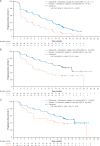Clinical considerations of the role of palbociclib in the management of advanced breast cancer patients with and without visceral metastases
- PMID: 29342248
- PMCID: PMC5888946
- DOI: 10.1093/annonc/mdx797
Clinical considerations of the role of palbociclib in the management of advanced breast cancer patients with and without visceral metastases
Abstract
Background: This report assesses the efficacy and safety of palbociclib plus endocrine therapy (ET) in women with hormone receptor-positive, human epidermal growth factor receptor 2-negative advanced breast cancer (ABC) with or without visceral metastases.
Patients and methods: Pre- and postmenopausal women with disease progression following prior ET (PALOMA-3; N = 521) and postmenopausal women untreated for ABC (PALOMA-2; N = 666) were randomized 2 : 1 to ET (fulvestrant or letrozole, respectively) plus palbociclib or placebo. Progression-free survival (PFS), safety, and patient-reported quality of life (QoL) were evaluated by prior treatment and visceral involvement.
Results: Visceral metastases incidence was higher in patients with prior resistance to ET (58.3%, PALOMA-3) than in patients naive to ET in the ABC setting (48.6%, PALOMA-2). In patients with prior resistance to ET and visceral metastases, median PFS (mPFS) was 9.2 months with palbociclib plus fulvestrant versus 3.4 months with placebo plus fulvestrant [hazard ratio (HR), 0.47; 95% confidence interval (CI), 0.35-0.61], and objective response rate (ORR) was 28.0% versus 6.7%, respectively. In patients with nonvisceral metastases, mPFS was 16.6 versus 7.3 months, HR 0.53; 95% CI 0.36-0.77. In patients with visceral disease and naive to ET in the advanced disease setting, mPFS was 19.3 months with palbociclib plus letrozole versus 12.9 months with placebo plus letrozole (HR 0.63; 95% CI 0.47-0.85); ORR was 55.1% versus 40.0%; in patients with nonvisceral disease, mPFS was not reached with palbociclib plus letrozole versus 16.8 months with placebo plus letrozole (HR 0.50; 95% CI 0.36-0.70). In patients with prior resistance to ET with visceral metastases, palbociclib plus fulvestrant significantly delayed deterioration of QoL versus placebo plus fulvestrant, whereas patient-reported QoL was maintained with palbociclib plus letrozole in patients naive to endocrine-based therapy for ABC.
Conclusions: Palbociclib plus ET prolonged mPFS in patients with visceral metastases, increased ORRs, and in patients previously treated for ABC, delayed QoL deterioration, presenting a standard treatment option among patients with visceral metastases amenable to endocrine-based therapy.
Clinical trial registration: NCT01942135, NCT01740427.
Figures





Similar articles
-
Analysis of subsequent therapy in Japanese patients with hormone receptor‒positive/human epidermal growth factor receptor 2‒negative advanced breast cancer who received palbociclib plus endocrine therapy in PALOMA-2 and -3.Breast Cancer. 2021 Mar;28(2):335-345. doi: 10.1007/s12282-020-01162-4. Epub 2020 Oct 21. Breast Cancer. 2021. PMID: 33085032 Free PMC article. Clinical Trial.
-
Palbociclib plus endocrine therapy in older women with HR+/HER2- advanced breast cancer: a pooled analysis of randomised PALOMA clinical studies.Eur J Cancer. 2018 Sep;101:123-133. doi: 10.1016/j.ejca.2018.05.017. Epub 2018 Jul 25. Eur J Cancer. 2018. PMID: 30053671
-
Clinical efficacy of CDK4/6 inhibitor plus endocrine therapy in HR-positive/HER2-0 and HER2-low-positive metastatic breast cancer: a secondary analysis of PALOMA-2 and PALOMA-3 trials.EBioMedicine. 2024 Jul;105:105186. doi: 10.1016/j.ebiom.2024.105186. Epub 2024 Jun 10. EBioMedicine. 2024. PMID: 38861871 Free PMC article. Clinical Trial.
-
Palbociclib: A Novel Cyclin-Dependent Kinase Inhibitor for Hormone Receptor-Positive Advanced Breast Cancer.Ann Pharmacother. 2015 Nov;49(11):1252-60. doi: 10.1177/1060028015602273. Epub 2015 Aug 31. Ann Pharmacother. 2015. PMID: 26324355 Free PMC article. Review.
-
Endocrine treatment versus chemotherapy in postmenopausal women with hormone receptor-positive, HER2-negative, metastatic breast cancer: a systematic review and network meta-analysis.Lancet Oncol. 2019 Oct;20(10):1360-1369. doi: 10.1016/S1470-2045(19)30420-6. Epub 2019 Sep 4. Lancet Oncol. 2019. PMID: 31494037
Cited by
-
Symptomatic bone marrow metastases in breast cancer: A retrospective cohort study.Front Oncol. 2022 Dec 19;12:1042773. doi: 10.3389/fonc.2022.1042773. eCollection 2022. Front Oncol. 2022. PMID: 36605432 Free PMC article.
-
Palbociclib in metastatic breast cancer: current evidence and real-life data.Drugs Context. 2019 Jul 16;8:212579. doi: 10.7573/dic.212579. eCollection 2019. Drugs Context. 2019. PMID: 31391852 Free PMC article. Review.
-
Clinical Features and Serological Markers Risk Model Predicts Overall Survival in Patients Undergoing Breast Cancer and Bone Metastasis Surgeries.Front Oncol. 2021 Sep 17;11:693689. doi: 10.3389/fonc.2021.693689. eCollection 2021. Front Oncol. 2021. PMID: 34604031 Free PMC article.
-
Real-World Clinical Data of Palbociclib in Asian Metastatic Breast Cancer Patients: Experiences from Eight Institutions.Cancer Res Treat. 2021 Apr;53(2):409-423. doi: 10.4143/crt.2020.451. Epub 2020 Oct 28. Cancer Res Treat. 2021. PMID: 33138346 Free PMC article.
-
CDK4/6 inhibition in low burden and extensive metastatic breast cancer: summary of an ESMO Open-Cancer Horizons pro and con discussion.ESMO Open. 2019 Nov 13;4(6):e000565. doi: 10.1136/esmoopen-2019-000565. eCollection 2019. ESMO Open. 2019. PMID: 31798979 Free PMC article. Review.
References
-
- Rugo H, Rumble B, Macrae E. et al. Endocrine therapy for hormone receptor–positive metastatic breast cancer: American Society of Clinical Oncology guideline. JCO 2016; 34: 3069–3103. - PubMed
-
- Cardoso F, Costa A, Senkus E. et al. 3rd ESO-ESMO international consensus guidelines for advanced breast cancer (ABC 3). Breast 2017; 31: 244–259. - PubMed
-
- National Comprehensive Cancer Network. NCCN Clinical Practice Guidelines in Oncology (NCCN Guidelines). Breast Cancer. Version 2.2017. https://www.nccn.org/store/login/login.aspx? ReturnURL=https://www.nccn.... (5 July 2017, date last accessed).
Publication types
MeSH terms
Substances
Associated data
LinkOut - more resources
Full Text Sources
Other Literature Sources
Medical
Research Materials

